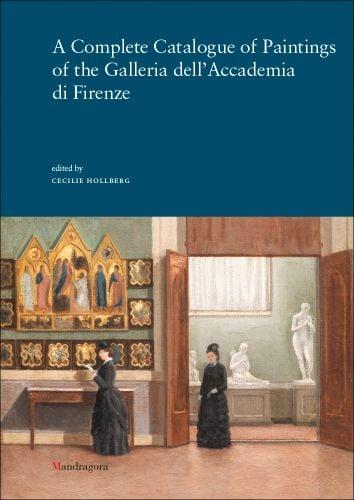

The Picture Collections of the Galleria dell’Accademia di Firenze
cecilie hollberg
From Agnolo Gaddi to Stefano Ussi, from the 13th century to the year 2000, this volume brings together the picture collections (including a few photographs) of the Galleria dell’Accademia di Firenze – a highly prestigious institution with a long history – for the very first time.
The Galleria dell’Accademia di Firenze is one of the world’s best-loved museums while also being the most Florentine museum, housing collections of great importance with a particular focus on the art and artists of Florence.
History
The museum opened in 1882 and formed part of the royal museums and galleries. Specially constructed to accommodate Michelangelo’s statue of David, the basilica-shaped building, designed by architect Emilio De Fabris, is centred around the Tribuna (the great exhibition hall), where instead of a high altar we see the Renaissance icon illuminated by the natural light falling on it through the skylight. As regards the origins of the museum, a clue is provided by its name Galleria dell’Accademia.
In 1563, under Cosimo I de’ Medici, the Accademia delle Arti del Disegno was founded by Giorgio Vasari with the aim of teaching the arts and sciences. Peter Leopold I, Grand Duke of Tuscany, sought to modernize the Accademia delle Arti del Disegno, reorganized it in 1784 and renamed it the Accademia di Belle Arti. This new institution occupied the premises of the 14th-century hospital of San Matteo and those of the convent of the nuns of San Niccolò di Cafaggio, obtaining two exhibition galleries. Initially, the Galleria dell’Accademia served the educational purpose of bringing fine art students closer to the great and famous artists of the past, giving them the opportunity to study and copy ancient works. As a free public institute, it was intended to train young artists.
Over the years, the museum added to its collections thanks to the suppression of ‘convents deemed socially worthless’ ordered by Peter Leopold in 1786.1 Following the annexation of the Grand Duchy of Tuscany to the Napoleonic Empire in December 1807, not only was the territory reorganized, but the assets and income of the religious institutes were also surveyed. The imperial decree of 24 March 1808 sanctioned the suppression of abbeys, convents and monasteries, turning over their assets to the state.
Pacino di Bonaguida
(Florence, documented from 1303 to c. 1330)
Considered one of the main exponents of Florentine painting and illumination in the first half of the 14th century, Pacino di Bonaguida may have trained in the workshop of the Master of St Cecilia and was active in the years between 1295 and 1345. There is little remaining documentary evidence of his life: a deed dated 20 February 1303 records him in association with the painter Tambo di Serraglio, while in around 1330 he registered for the first time with the Guild of Doctors and Apothecaries. A reliable point for the reconstruction of the corpus of his works is the San Firenze polyptych, now in the Galleria dell’Accademia, signed at the bottom and probably executed in the years 1315–20. One of the artist’s most notable masterpieces is the painting of the Lignum vitae, also in the Accademia, which is a translation into images of the treatise of the same name by St Bonaventure of Bagnoregio. [EA]

197.
Pacino di Bonaguida
(Florence, documented from 1303 to c. 1330)
Bishop Saint (Nicholas?); St John the Evangelist; Bishop Saint (Proculus?)
c. 1305–10
tempera on panel; 71 × 48.5 × 3 cm each inv. 1890 nos. 8698, 8699, 8700
Provenance of the Bishop Saint (Nicholas?); St John the Evangelist: Valori Chapel, church of San Procolo, Florence (until 1778); church of the Badia, Florence (1778–probably until c. 1810); Galleria dell’Accademia di Firenze (c. 1810/exhibited 1851–93); in storage, Galleria dell’Accademia di Firenze (1893–1931); Galleria dell’Accademia di Firenze (1931–42); Castello di Montegufoni, Montespertoli (FI; safekeeping during the war, 1942–5); Galleria dell’Accademia di Firenze (from 1945).
Provenance of the Bishop Saint (Proculus?): Valori Chapel, church of San Procolo, Florence (until 1778);
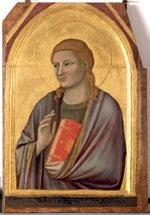

church of the Badia, Florence (1778–probably until c. 1810); in storage, Ricetto della Scuola del Nudo, Galleria dell’Accademia di Firenze (c. 1810–exhibited 1884); Galleria dell’Accademia di Firenze (exhibited 1884–93); in storage, Galleria dell’Accademia di Firenze (1893–1931); Galleria dell’Accademia di Firenze (1931–42); Castello di Montegufoni, Montespertoli (FI; safekeeping during the war, 1942–5); Galleria dell’Accademia di Firenze (from 1945).
The three panels, which were originally pointed, come from a polyptych with the Madonna and Child in the centre and four saints at the sides. A predella with Stories of St Proculus, which is now split between various museums, also formed part of this complex. The depiction of the saints as half-length figures is reminiscent of 13th-century polyptychs, while the stylistic solutions adopted show Pacino’s approach to the Giottesque manner in around the first decade of the 14th century. [EA]
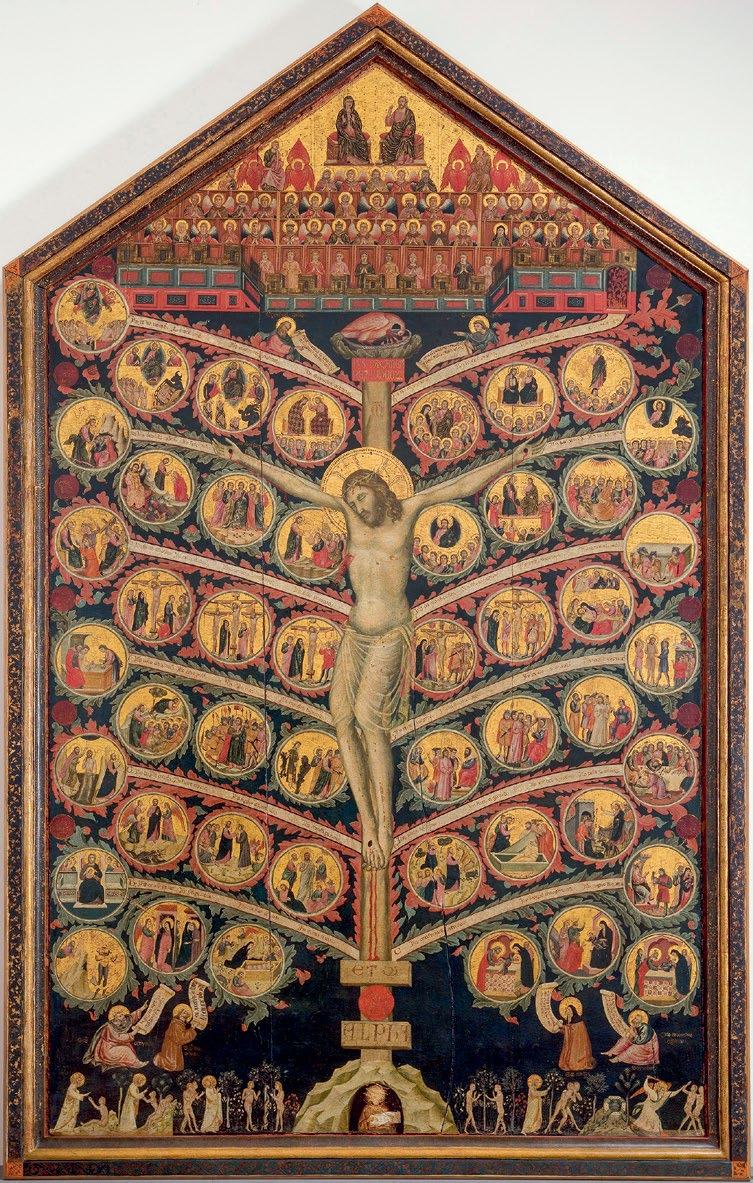
Pacino di Bonaguida
198.
Pacino di Bonaguida (Florence, documented from 1303 to c. 1330) The Tree of Life (Scenes from the Life of Christ) Pinnacle: The Virgin and Christ Enthroned, with Four Tiers of Saints, Angels and Beatified People; below: Mystical Pelican between the Prophets Ezekiel and Daniel Base: Seven Stories from Genesis (The Creation of Adam and Eve; God Indicating the Forbidden Tree to Adam and Eve; The Temptation; Eve Offers the Forbidden Fruit to Adam; Original Sin; God Rebukes Adam and Eve; The Four Rivers of Paradise and the Expulsion from Eden); above: Moses; St Francis; St Clare; St John the Evangelist
c. 1310–15
tempera on panel; 271 × 170.5 × 12 cm inv. 1890 no. 8459
Provenance : convent of the Poor Clares of Santa Ma-
ria di Monticelli, Florence (until 1531); convent of Santa Maria Assunta in Montedomini, Florence (1531–1808); Pia Casa di Lavoro di Montedomini, Florence (1808–49); Galleria dell’Accademia di Firenze (exhibited 1850–1942); Castello di Montegufoni, Montespertoli (FI; safekeeping during the war, c. 1942–5); Galleria dell’Accademia di Firenze (from c. 1945).
This is a complex depiction of a symbolic nature, replete with inscriptions and iconography, inspired by Bonaventure of Bagnoregio’s Lignum Vitae, a fundamental text on medieval Franciscan spirituality. The protagonist of the composition is Jesus crucified on a tree with twelve branches, each of which supports medallions with Stories from the Life of Christ, in a reading order that proceeds from bottom to top. The cave at the foot of the cross features a half-length portrait of St Bonaventure holding an open book, probably the same Lignum Vitae that inspired the composition. [EA]
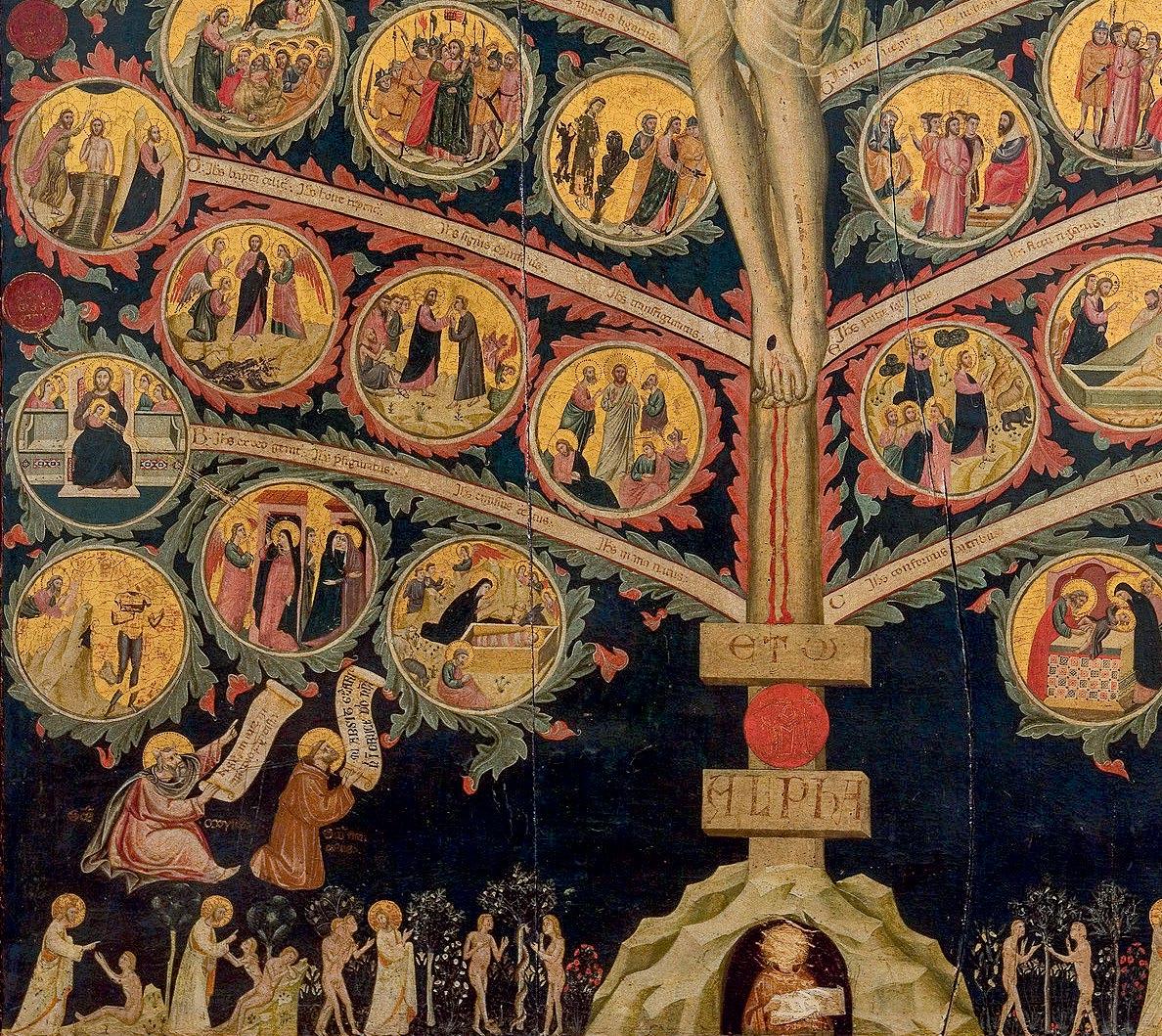
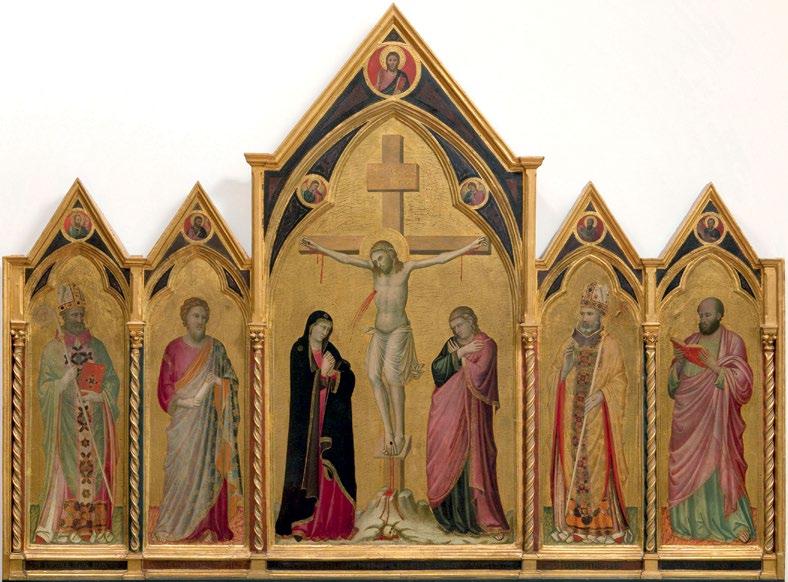
199.
Pacino di Bonaguida
(Florence, documented from 1303 to c. 1330)
Crucified Christ between the Virgin and St John the Evangelist in Mourning; upper roundel: Blessing Redeemer; roundels: Adoring Angels
Left compartments: St Nicholas of Bari; St Bartholomew; roundels: Prophets
Right compartments: St Florentius; St Luke; roundels: Prophets
c. 1315–20
tempera on panel; 190 × 249 × 12.5 cm inv. 1890 no. 8568
Provenance : church of San Firenze, Florence (until 1772 [on the high altar until before 1733]); caretaker’s lodge, convent of San Firenze, Florence (1772–1848); Gallerie Fiorentine, Florence (1848–before 1850); Gal-
leria dell’Accademia di Firenze (exhibited 1850–1942); Castello di Montegufoni, Montespertoli (FI; safekeeping during the war, 1942–c. 1945); Galleria dell’Accademia di Firenze (from c. 1945).
This five-compartment polyptych is signed and dated incompletely in the inscription at the base of the central panel, which reads SYMON [P]R[ES]B[I]TER S[ANCTI] FLOR[ENTI] FEC[IT] PI[N]GI H[OC] OP[US] A PACINO BONAGUIDE AN[N]O D[OMI]NI MCCCX[…] . Fundamental to establishing the artist’s catalogue, it is one of the earliest Florentine examples of a polyptych with full-length saints, inspired by the back of Giotto’s Santa Reparata polyptych, housed in the cathedral of Santa Maria del Fiore in Florence. [EA]
Pacino di Bonaguida
200.
Pacino di Bonaguida (Florence, documented from 1303 to c. 1330) Madonna and Child
c. 1320
tempera on panel; 81 × 51.5 × 5 cm inv. 1890 no. 6146
Provenance : unknown location; Gallerie Fiorentine, Florence (1881–?); in storage, Deposito Archibusieri, Galleria degli Uffizi, Florence (?–1935); Galleria dell’Accademia di Firenze (1936–42); Castello di Montegufoni, Montespertoli (FI; safekeeping during the war, 1942–c. 1945); Galleria dell’Accademia di Firenze (from c. 1945).
This curved panel is the central element of a dispersed polyptych, the sides of which probably included a panel with St James the Great, formerly in a private collection in New York, and another with St Bartholomew, now in the Barnes Foundation in Philadelphia. The figurative language, which is more sculptural and monumental than in his early works, testifies to the artist’s closeness to Giottesque models. [EA]
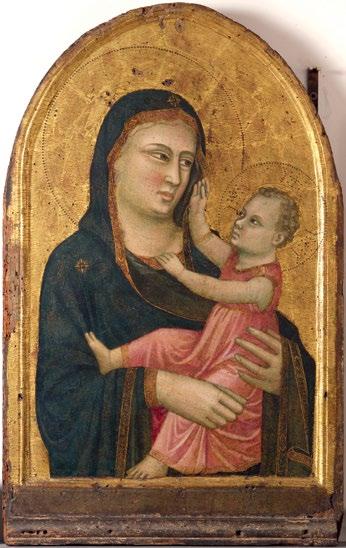
201.
Pacino di Bonaguida
(Florence, documented from 1303 to c. 1330)
Madonna and Child Enthroned between Sts Peter and Paul and Two Martyred Female Saints
Left compartment: Martyred Deacon Saint; St John the Baptist and St Christopher Right compartment: Crucifixion between the Virgin and St John the Evangelist in Mourning
c. 1325–30
tempera on panel; 50 × 45.4 × 6.5 cm inv. 1890 no. 9806
Provenance : unknown location; Fondazione Carlo Marchi, Florence (1947–83); Galleria d’Arte Moderna, Palazzo Pitti, Florence (1983–5); Galleria degli Uffizi, Florence (1985–2019); Galleria dell’Accademia di Firenze (from 2019).
This small tabernacle with wings, which is intact throughout, is notable for the accuracy of the details and its lavish decoration with punches, ge-
Paolo di Dono known as (➨ Paolo Uccello)
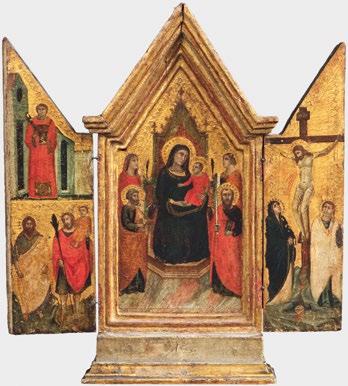
ometric shapes and rosettes, unusual in panel paintings by this artist. Intended for private devotion, the work was also particularly suitable for taking on journeys, due to its small size. [EA]
Paolo Uccello (Paolo di Dono known as; Florence, 1397–1475)
Paolo Uccello is considered one of the most original exponents of 15th-century Florentine painting, a refined and visionary interpreter of a transitional culture, spanning the fairy-tale atmospheres of the Late Gothic period and the innovations of the Renaissance. Little is known of his early activity: in 1407 he is documented as a pupil of Lorenzo Ghiberti working on the North Door of Florence Baptistery; in 1417 he was enrolled in the Guild of Doctors and Apothecaries; between 1425 and around 1430 he stayed in Venice. After returning to Tuscany in the 1430s, he frescoed the Green Cloister in the Florentine convent of Santa Maria Novella (completed in 1447), the chapel of the Assumption in the Duomo in Prato and the Equestrian Monument to John Hawkwood inside the cathedral of Santa Maria del Fiore (signed and dated 1436). Sources recall his extensive interest in researching perspective and geometry, as can be observed in his most famous paintings, including, in addition to the abovementioned works, the three panels with the Battle of San Romano (c. 1438), which are divided between the National Gallery in London, the Louvre and the Uffizi, and St George and the Princess also in the National Gallery in London (1456). During the final phase of his career, the artist was active in Urbino in the court of the Montefeltro family [EA]
202.
Paolo Uccello, Paolo di Dono known as (Florence, 1397–1475) Allegory of Monastic Life
c. 1460–5
tempera on canvas; 96 × 126 × 5.6 cm inv. 1890 no. 5381
Provenance : convent of San Giorgio e dello Spirito Santo alla Costa, Florence (until 1810); Galleria dell’Accademia di Firenze (1810–53); Galleria degli Uffizi, Florence (1853–c. 1920); Galleria dell’Accademia di Firenze (c. 1920–42); Castello di Montegufoni, Montespertoli (FI; safekeeping during the war, 1942–5); Galleria dell’Accademia di Firenze (from 1945).
This scene, set in a rugged rocky landscape against a backdrop of cultivated fields and a fortified city, shows various episodes and examples of ascetic life, including St Francis receiving the stigmata, St Jerome praying before the Crucifix,
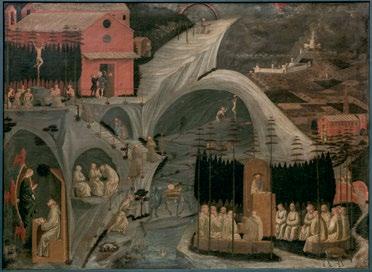
the apparition of the Virgin to St Bernard, and the preaching of St Benedict. This enigmatic work, previously interpreted as a Thebaid, probably alludes to a journey of spiritual elevation through hermitic and monastic practice. [EA]
245. Taddeo Gaddi
(Florence, documented c. 1330–66)
Stories from the Life of Christ and the Life of St Francis
tempera on panel c. 1335–40
Storie from the Life of Christ
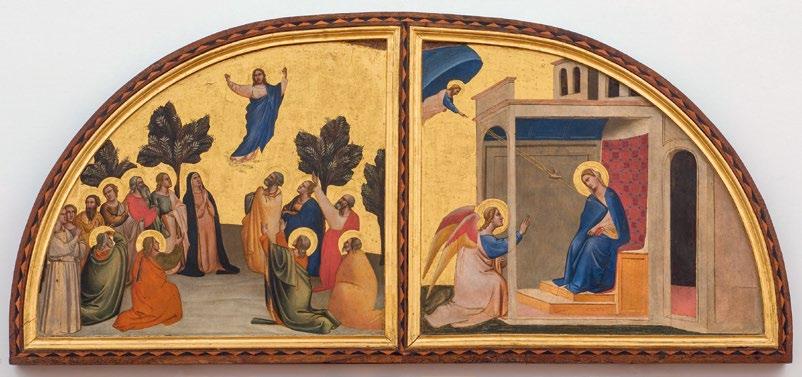
Ascension of Christ; Annunciation
72.5 × 160 × 6.5 cm inv. 1890 no. 8581

Visitation
48 × 42 × 4.8 cm
inv. 1890 no. 8582
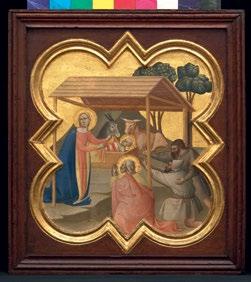
Nativity
48.5 × 43 × 5.5 cm
inv. 1890 no. 8583
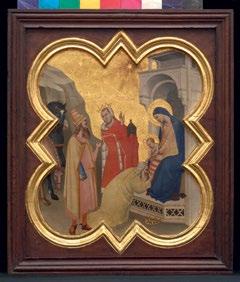
Adoration of the Magi
48 × 43 × 4.8 cm
inv. 1890 no. 8584
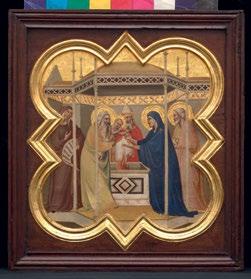
Presentation of Jesus at the Temple
48.5 × 43.2 × 4.8 cm
inv. 1890 no. 8585
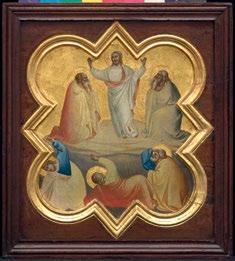
Transfiguration
48 × 43 × 4.8 cm
inv. 1890 no. 8588

Resurrection of Christ
48 × 43 × 4.8 cm
inv. 1890 no. 8591
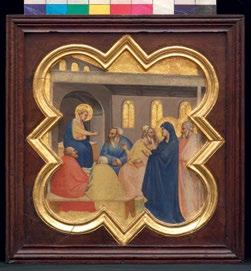
Disputation with the Doctors
46.8 × 43.5 × 5 cm
inv. 1890 no. 8586
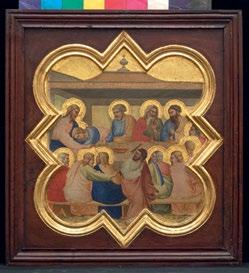
Last Supper
47 × 43.7 × 4.8 cm
inv. 1890 no. 8589

Apparition to the Marys
48 × 43 × 4.8 cm
inv. 1890 no. 8592
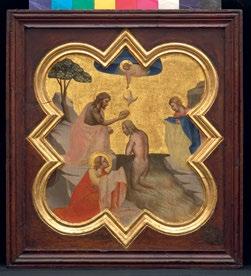
Baptism of Jesus
47.5 × 43.3 × 4.8 cm
inv. 1890 no. 8587
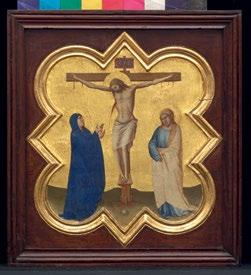
Crucifixion
48 × 43 × 4.8 cm
inv. 1890 no. 8590

Incredulity of St Thomas
48 × 44 × 4.8 cm
inv. 1890 no. 8593
Tommaso del Mazza
(Master of St Verdiana; Florence, documented between 1377 and 1391)
Only recently have critics attributed Tommaso del Mazza with the works that had been incorporated into the corpus of the so-called Master of St Verdiana. Tommaso trained in the painting styles of Andrea Orcagna, Agnolo Gaddi and Niccolò di Pietro Gerini. Having joined the Guild of Doctors and Apothecaries in 1377 and enrolled in the Compagnia di San Luca in 1390, he was active not only as a painter but also as an illuminator. Highly appreciated by his contemporaries, as shown by the commissions he received even outside the city, sources report his collaborations with Pietro Nelli and Niccolò di Pietro Gerini. In the works he produced at the end of his career, in which typical neo-Giottesque influences continue to persist, Tommaso’s interest in the Gothic style shines through, particularly in the slenderer figures, softer and more sinuous contours, and the increased taste for decoration. [fb]
248.
Tommaso del Mazza
(Master of St Verdiana; Florence, documented between 1377 and 1391)
Celestial Madonna of Humility between Four Angels, a Deacon Saint and Sts Francis, John the Baptist, Paul, Anthony Abbot and Catherine of Alexandria
c. 1370–5
tempera on panel; 88.5 × 50.5 × 7 cm inv. 1890 no. 3156
Provenance: gallery, hospital of Santa Maria Nuova, Florence (until 1900); Galleria degli Uffizi, Florence (1900–13); in storage, Galleria degli Uffizi, Florence (1913–33); Galleria dell’Accademia di Firenze (1933–42); Castello di Montegufoni, Montespertoli (FI; safekeeping during the war, 1942–5); Galleria dell’Accademia di Firenze (from 1945).
This small panel was originally intended for private devotion. It still has the original frame, including the two twisted columns at the sides and the hanging arches that line the upper part. Unfortunately, it is no longer possible to read the coats of arms at the sides of the plinth, which would have made it possible to identify the patron. [fb]

249.
Tommaso del Mazza
(Master of St Verdiana; Florence, documented between 1377 and 1391)
St Leonard of Noblac with Praying Figure
c. 1375
tempera on panel; 82 × 38.5 × 5 cm inv. 1890 no. 10763
Provenance : unknown location; private collections, Florence (?–2019); compulsory purchase by the Export Office, Genoa (2019); Galleria dell’Accademia di Firenze (from 2019).
This panel was the left compartment of a polyptych, most probably the one originally displayed in the Regnadori Chapel of the church of San Francesco in Prato. The presence of St Leonard of Noblac, healer of diseases and protector of prisoners, is probably linked to the name or biography of a member of the Regnadori family, who commissioned the work. [fb]
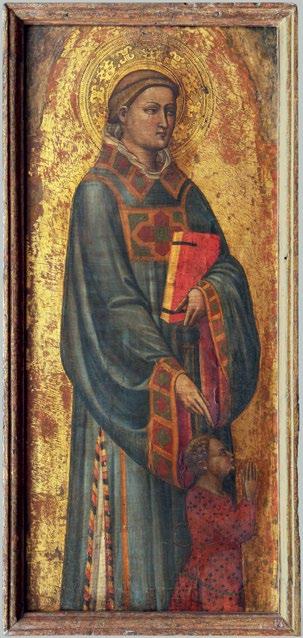
Tommaso di Stefano known as (➨ Giottino)
Tosini, Michele known as (➨ Michele di Ridolfo del Ghirlandaio)
Tommaso del Mazza
